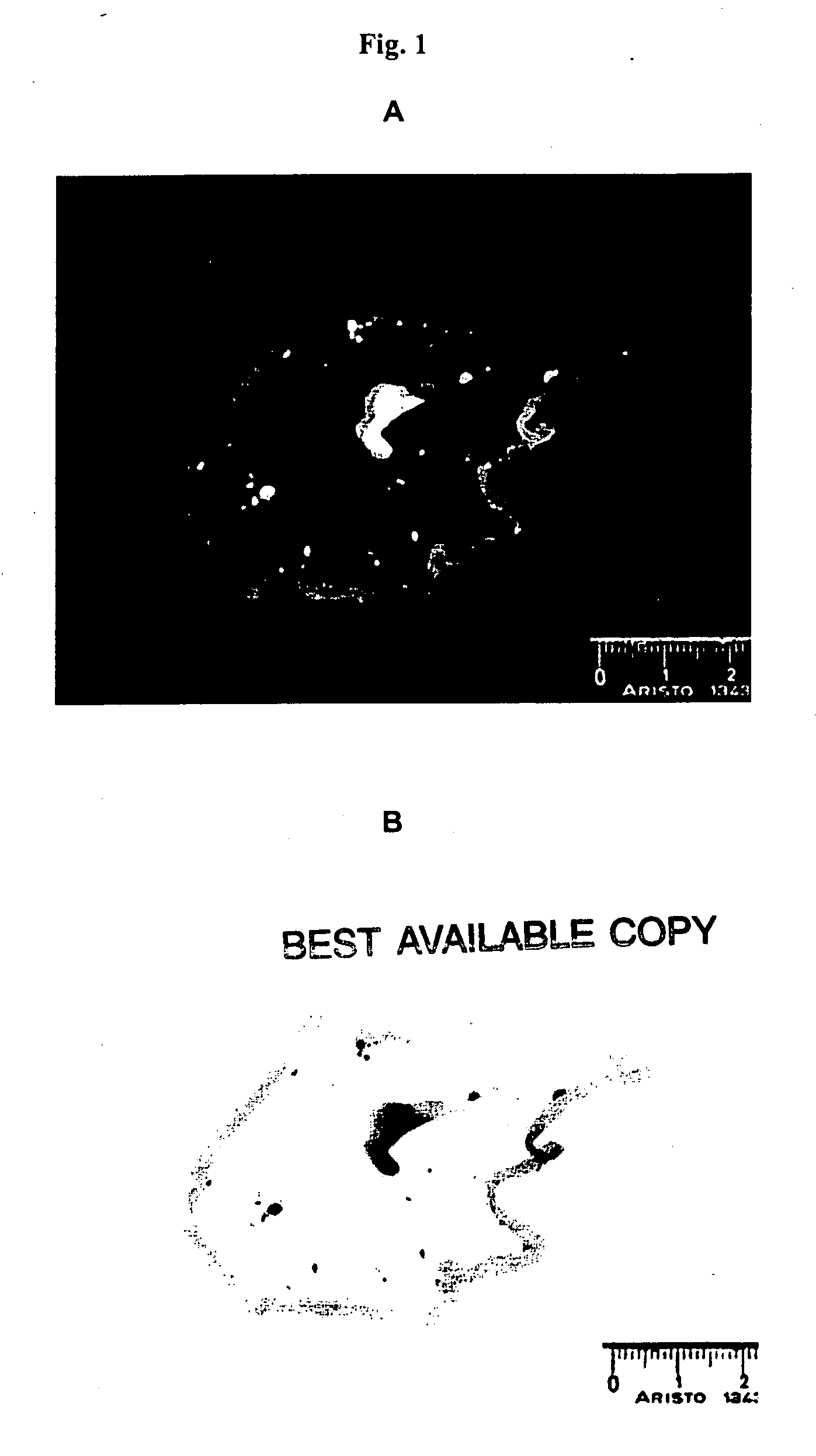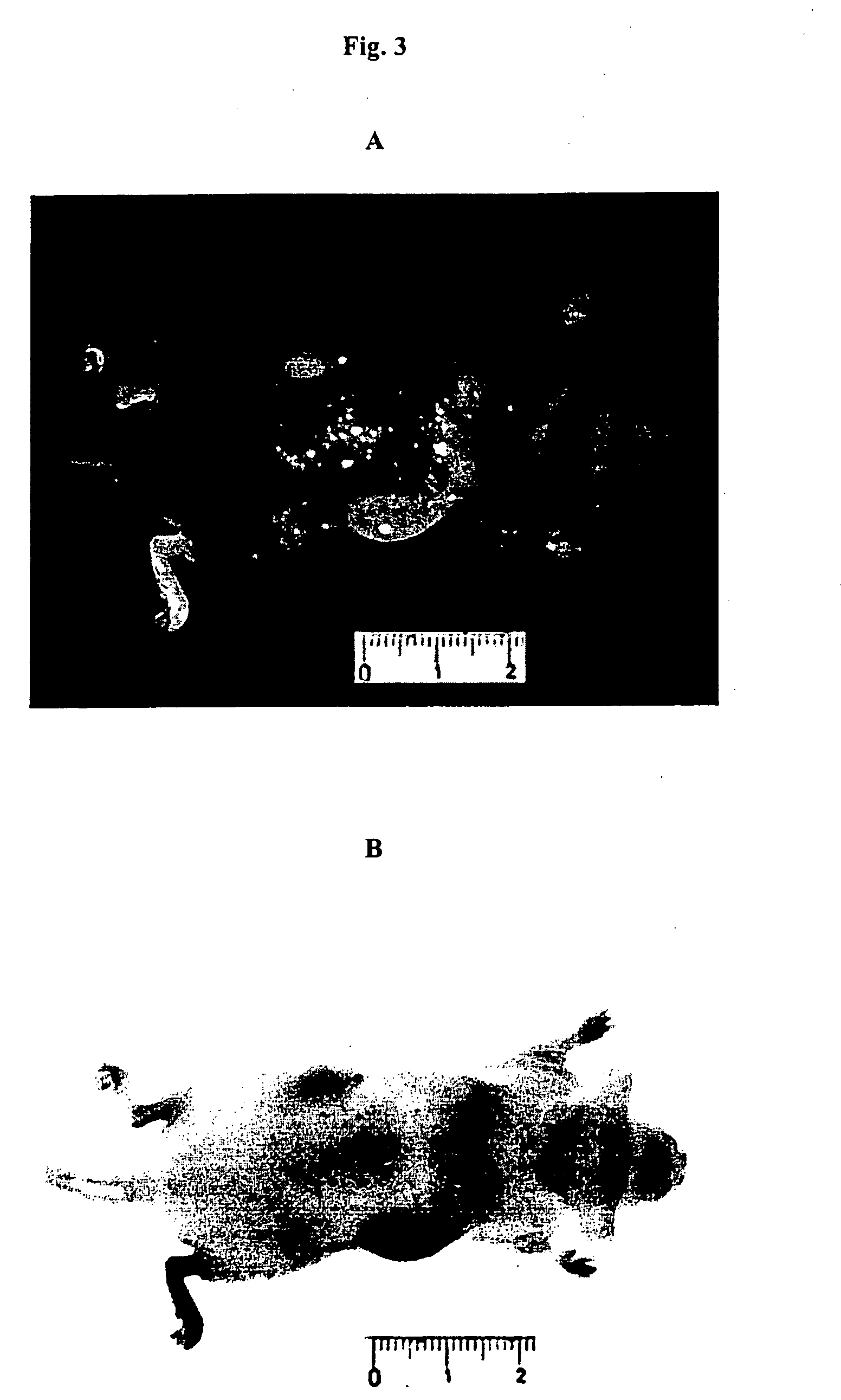Use of cyanine dyes for the diagnosis of disease associated with angiogenesis
a technology of angiogenesis and cyanine dye, which is applied in the direction of diagnostic recording/measuring, instruments, ultrasonic/sonic/infrasonic diagnostics, etc., can solve the problems of high signal-to-noise ratio, low specificity, and the way of living tissue images at much lower resolution and specificity
- Summary
- Abstract
- Description
- Claims
- Application Information
AI Technical Summary
Benefits of technology
Problems solved by technology
Method used
Image
Examples
examples 1-16
Synthesis of Indotricarbocyanine Dyes with Maleimide Groups
example 1
Trisodium 3,3-dimethyl-2-{7-[3,3-dimethyl-5-sulfonato-1-(2-sulfonatoethyl)-3H-indolium-2-yl]-4-(2-{[2-(2,5-dioxo-2,5-dihydro-1H-pyrrol-1-yl)ethyl]carbamoyl}-ethyl)hepta-2,4,6-trien-1-ylidene}-1-(2-sulfonatoethyl)-2,3-dihydro-1H-indole-5-sulfonate, internal salt (Formula XVIII)
[0100]
a) 1-(2-Sulfonatoethyl)-2,3,3-trimethyl-3H-indolenine-5-sulfonic acid, internal salt
[0101] 10 g (0.04 mol) of 2,3,3-trimethyl-3H-indolenine-5-sulfonic acid (Bioconjugate Chem 1993, 4, 105), 6.8 g (0.04 mol) of 2-chloroethanesulfonic acid chloride and 4.2 g (0.04 mol) of triethylamine are refluxed in 200 ml of acetonitrile for 6 hours. The precipitate is suctioned off and dried. Yield 5.0 g (35% of theory). Anal Biochem 1994, 217, 197
b) 3-Pyridin-4-yl-propionic acid-tert-butyl ester
[0102] 20 g (89 mmol) of t-butyl-P,P-dimethylphosphonoacetate in 50 ml of THF is added in drops at 0° C. to a suspension of 3.9 g (98 mmol) of sodium hydride (60% in mineral oil) in 250 ml of THF. After 1 hour of stirring at...
example 2
Trisodium 3,3-dimethyl-2-{7-[3,3-dimethyl-5-sulfonato-1-(2-sulfonatoethyl)-3H-indolium-2-yl]-4-(2-{[6-(2,5-dioxo-2,5-dihydro-1H-pyrrol-1-yl)hexyl]carbamoyl}ethyl)hepta-2,4,6-trien-1-ylidene}-1-(2-sulfonatoethyl)-2,3-dihydro-1H-indole-5-sulfonate, internal salt (Formula XIX)
[0108]
[0109] The synthesis is carried out analogously to Example 1e) from 0.4 g (0.45 mmol) of the title compound of Example 1d) and 0.21 g (0.68 mmol) of N-(6-aminohexyl)maleimide-trifluoroacetate (Int J Pept Protein Res 1992, 40, 445). Yield: 0.38 g of a blue lyophilizate (81% of theory).
[0110] Elementary analysis: Cld.: C, 49.25; H, 4.79; N, 5.22; S, 11.95; Na, 6.43. Fnd.: C, 48.96; H, 4.92; N, 5.32; S, 11.88; Na, 6.56.
PUM
| Property | Measurement | Unit |
|---|---|---|
| Diameter | aaaaa | aaaaa |
| Diameter | aaaaa | aaaaa |
| Diameter | aaaaa | aaaaa |
Abstract
Description
Claims
Application Information
 Login to View More
Login to View More - R&D
- Intellectual Property
- Life Sciences
- Materials
- Tech Scout
- Unparalleled Data Quality
- Higher Quality Content
- 60% Fewer Hallucinations
Browse by: Latest US Patents, China's latest patents, Technical Efficacy Thesaurus, Application Domain, Technology Topic, Popular Technical Reports.
© 2025 PatSnap. All rights reserved.Legal|Privacy policy|Modern Slavery Act Transparency Statement|Sitemap|About US| Contact US: help@patsnap.com



